| Article ID | Journal | Published Year | Pages | File Type |
|---|---|---|---|---|
| 72522 | Microporous and Mesoporous Materials | 2015 | 11 Pages |
•–COOH functionalized FDU-12 mesoporous silicas were used for lysozyme immobilization.•A remarkably high adsorption capacity of 895 mg g−1 was obtained with FTC-30.•A good enzymatic activity of lysozyme was retained after immobilization.•A very low leaching rate (1%) of lysozyme was observed after 24 h.
Cage-type cubic mesoporous silicas FDU-12 functionalized with a tunable content of carboxylic acid (–COOH) groups, ranging from 0 to 50 mol% based on silica, were used for immobilization of lysozyme. The particle size of –COOH functionalized FDU-12 was highly dependent on the relative amount of carboxyethylsilanetriol sodium salt (CES) and tetraethoxysilane (TEOS) in the reaction mixture. The particle size was around 200 nm for the materials prepared with the CES/(TEOS + CES) molar ratio of 20%–30%. The combination of –COOH functionalization and nanoscale dimension significantly enhanced the lysozyme adsorption capacity of the prepared materials. A remarkably high adsorption capacity of 895 mg g−1 at 37 °C (pH 9.6) was attained with the FDU-12 nanostructure functionalized with 30 mol% of –COOH groups. Meanwhile, the structural stability of lysozyme was unaltered after immobilization. A very low leaching rate was observed, indicating that protein molecules were tightly adsorbed onto the –COOH functionalized FDU-12 nanostructures due to the strong electrostatic interactions between the adsorbent and the lysozyme molecule. The zeta potentials of the materials also correspond well to their adsorption capacities observed. The enzymatic activity of the immobilized lysozyme was also examined as a function of the –COOH contents present on the mesopore surface of the materials.
Graphical abstractFigure optionsDownload full-size imageDownload as PowerPoint slide
